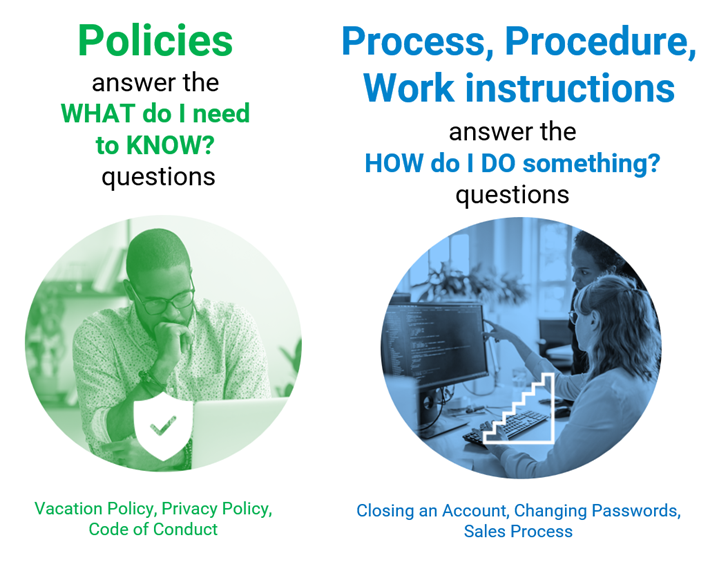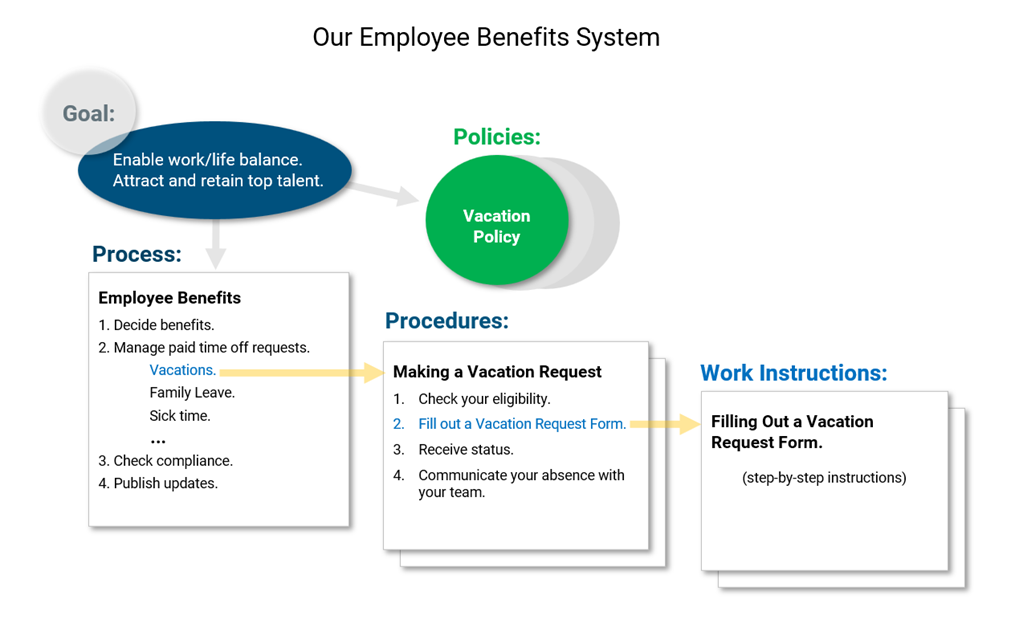When it comes to documenting policies, processes, procedures, and work instructions, everyone agrees: employees need access to clear, accurate information at the exact moment they need it. That’s how you drive performance, reduce risk, and support a confident, capable workforce.
But even with good intentions—and hundreds of staff hours—many organizations fall short. Content is confusing, unused, or buried. Often, it’s because teams never clarified the differences between policy, process, procedure, and work instructions. They just started writing.
Why it matters
Each type of documentation serves a unique purpose and audience. Senior leaders need high-level policy guidance. Managers might be looking for process overviews. Frontline employees often need step-by-step task instructions. If it’s all jumbled together, no one gets what they need.
That leads to:
- Confused employees
- Slower operations
- Regulator pushback
- Unnecessary rework and errors
Mixing document types also makes maintenance a nightmare. We’ve seen it firsthand. One financial institution had a single policy—“Account Titling Guidelines”—written multiple times across their documentation, each version slightly different. This inconsistency triggered a compliance violation. We helped them fix it by creating a single, authoritative policy document and linking it wherever needed. Updates now happen in one place, saving time and reducing risk.
The bottom line: clarity pays off
When you clearly define and separate your documentation types:
- Employees get what they need, fast
- Compliance becomes easier to maintain
- Maintenance time drops significantly
- Confidence, consistency, and efficiency go up
Here’s how to make that happen.
Definitions and Best Practices for Policy, Process, Procedure, and Work Instructions
What is a Policy?
A policy is a set of general guidelines or statements of position regarding a given topic.
At its core, the purpose of policies is to offer a structured set of principles or rules crafted to guide decision-making and behavior. A single policy can contain several policy provisions, and policies do not contain steps.
Effective policies ensure that actions align with the overarching goals and values of the entity creating them. While policies are separate, they should be linked to processes, procedures, and work instructions.
Examples of a policy:
-
Code of Conduct
-
Employee Security
-
Pricing Policy
-
Approved Carriers
What is a Process?
A process is the high-level description of a large task or series of related tasks – it provides the “big picture” and strategic objectives for employees.
Operational processes answer the questions: how does a particular function or area of your business work, and what happens? Providing employees with this view helps them see how everyone works together and how their role fits in.
Examples of a process:
- Hiring Process
- Commercial Lending
- Sales Process
- Employee Benefits System
- QA Process
- LMS Development Process
What is a Procedure?
A procedure is a detailed and structured series of steps or actions that outlines how a specific task or process should be executed within an organization.
Sometimes referred to as a standard operating procedure (SOP), a procedure is more detailed than a process and includes best practices for each specific task, but procedures are not as detailed as work instructions. A procedure tells how a series of sequential tasks should be performed to achieve a desired outcome. A procedure answers the questions: what happens, in what order, who does what to whom, and how?
Examples of a procedure:
-
Installing [name your application]
-
Tracing a Lost Payment
-
Submitting an Order
-
Preparing a Proposal
-
Planning a Webinar
-
Lock Out Tag Out
What is a Work Instruction?
A work instruction is a document with detailed instructions that provides specific guidance and step-by-step instructions on how to perform a particular task or job.
Work instructions are the most detailed descriptions of a task, include best practices for each specific task, and are typically carried out by one person from start to finish in one sitting. Work instructions change more frequently than processes and procedures. They should be separate but linked to the other elements.
Examples of a work instruction:
-
Changing Your Password
-
Completing an Expense Report
-
Running the Monthly Sales Report
Policy vs Tasks (Process, Procedure, Work Instruction)
Policy vs procedure may be the two terms that are most often confused – but they have key differences.
The content types used in any good system fall into these two main categories:
-
A policy is a guideline, standard or statement of position; policies have no action. Use policy documents to answer the, “what do I need to know?” questions.
-
Processes, procedures, work instructions are all tasks. The main difference is the level of detail. Use these content types to answer, “how do I do something?” questions.

Here’s an example most people can relate to:
Say you've been with a company for 9 months and want to see when you can take a vacation. To find your answer, you look up the company’s vacation policy. If you want to put in a vacation request, you can instantly jump to a related procedure that tells you how. That procedure might even have a link to a vacation request form that you can fill out and send to the HR Director.
Difference between process, procedure, work instruction
Before you start mapping out the actions for a task, stop and answer this question: how big of a job is it?
If it’s big, like “Employee Benefits,” it is typically a process. Processes often span across multiple departments and involve many people.
If it’s a detailed task, like “Completing a Vacation Time Request Form,” it’s a work instruction. Work instructions are tasks performed in one sitting from start to finish by one person.
Procedures are more detailed than processes, but not as detailed as work instructions.
Policy and Procedure: Why You Need Both
Creating policies without procedures and vice versa is a common mistake, especially when the focus is just on policy management.
Achieving business objectives requires that employees have access to both policies and procedures. Most regulations require both. Creating policies by themselves is a good start, but it’s equivalent to saying something like, “it is our policy to be an equal opportunity employer." It’s then up to the employees to figure out how to make that happen on their own. This is risky at best, and the end result can often be disastrous.
Avoid standalone procedures out of compliance or not synchronized with policies. “How-to” questions must get answered somehow. If your work procedures aren’t captured and cross-checked with stated policies, your organization will be inconsistent or even be noncompliant with legal, regulatory, or internal controls.
Mixing policy and procedure together in a single document
A common misconception – and this is held by many experts – is that there is a one-to-one correspondence between policy and procedure. In some cases, that’s true, but most of the time it is not! In real practice, a given policy may relate to multiple processes and procedures.
Hardwiring them together is old thinking and will create maintenance nightmares later. When a policy and procedure is in a single document, this makes it impossible to sort, track, or report just policies or just procedures. Content locked in a single document can’t be reused.
Are policies and procedures enough?
Some organizations stop at these two content types. They create policies and then everything else is procedure. We recommend you go a little further, keeping your audience in mind. Break out content and the type of document so it’s easy for your audience to find what is relevant to them.
How Policies and Processes, Procedures, and Work Instructions Fit Together
Using an example focused on Employee Benefits, the diagram below shows everything needed to carry out the process and how all the content pieces fit together. This framework accommodates the way people seek answers in daily situations, leading to faster, more accurate actions and better decisions. You have a system you can manage with, train from, and that regulators love.

The big picture process breaks down into multiple procedures and tasks. There are several policies pertaining to Employee Benefits. All of these content components work together as a system designed to achieve the goal: enabling an amazing Employee Benefits program.
Customize to your terminology
Keep in mind, the terminology you use may vary depending on industry standards. For example, instead of “procedure,” you may use the term protocol or SOP. Some people use the term desk procedure or job aid instead of work instruction. It doesn’t matter what you call these various content types as long as everyone understands their meaning and uses them consistently.
Discover a Better Policy and Procedure System
With Zavanta software, you can build an easy-to-understand information architecture for process improvement in any industry. You’ll experience writing support throughout your standard operating procedures documentation process via guided authoring, structured content, and content overlays. Track version control, approvals, and employee usage through the automation of the full life cycle of policy and procedure management.
Employees have the benefit of a superior user experience via a customized, branded employee portal and reader dashboard. They can quickly and easily access the most updated and relevant policy and procedure documents, and get back to their work.
By centralizing and standardizing your documentation processes through Zavanta, you not only mitigate risks associated with inconsistency but also empower your team with clear, accessible, and actionable guidelines.
Contact us today to start a conversation.
Additional Resources
.png?width=289&height=63&name=full%20logo%20(white).png)
